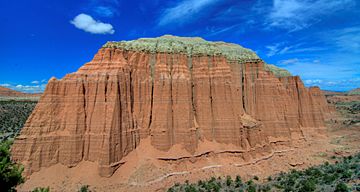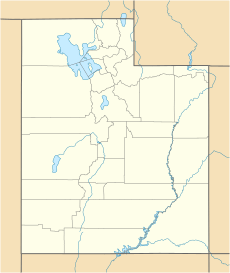Cathedral Mountain (Capitol Reef National Park) facts for kids
Quick facts for kids Cathedral Mountain |
|
|---|---|

Southwest aspect, May 2013
|
|
| Highest point | |
| Elevation | 6,924 ft (2,110 m) |
| Prominence | 384 ft (117 m) |
| Isolation | 1.89 mi (3.04 km) |
| Parent peak | Point 6984 |
| Geography | |
| Location | Capitol Reef National Park Wayne County, Utah, US |
| Parent range | Colorado Plateau |
| Topo map | USGS Cathedral Mountain |
| Geology | |
| Age of rock | Jurassic |
| Type of rock | Entrada Sandstone |
| Climbing | |
| Easiest route | class 5.x climbing |
Cathedral Mountain is a tall peak, about 6,924-foot (2,110 m) high. You can find it in Capitol Reef National Park in Utah, United States. It's a famous landmark in the park's beautiful Cathedral Valley.
Contents
What is Cathedral Mountain?
Cathedral Mountain is a huge rock formation that stands alone. It's about 13 miles (21 km) north of the park's main visitor center. It's also close to another peak called Needle Mountain. This area is known as Cathedral Valley.
In 1945, Charles Kelly, the first superintendent of Capitol Reef, named the valley. He thought the giant sandstone rocks looked like grand, old cathedrals. These "cathedrals" have fancy walls and tall spires, just like real church buildings. Cathedral Mountain itself rises over 500 feet (150 meters) from the valley floor. The Fremont River basin collects water from this area. The explorer John C. Frémont even traveled through Cathedral Valley way back in 1853.
How Cathedral Mountain Formed
Cathedral Mountain is made of reddish rock called Entrada Sandstone. It has a tough, grayish-green layer on top. This top layer is called the Curtis Formation. It acts like a protective hat, stopping the softer rock below from wearing away.
The sandstone started as sandy mud on an ancient tidal flat. Scientists believe it formed about 160 million years ago. This was during the Jurassic period, when dinosaurs roamed the Earth. At that time, this area was a huge sand sea, the biggest one ever!
The rock layers in Cathedral Valley look almost flat. But they actually tilt slightly to the east. Much later, the entire Colorado Plateau slowly lifted up. This lifting kept the rock layers mostly flat. However, Capitol Reef is special because of the Waterpocket Fold. This is a giant wrinkle in the Earth's crust. It formed between 50 and 70 million years ago.
Weather in Cathedral Valley
The best times to visit Cathedral Mountain are in spring and fall. The area has a "cold semi-arid climate." This means winters are cold, with average temperatures below 32°F (0°C). Most of the rain and snow falls in spring and summer.
This desert area gets less than 10 inches (250 millimeters) of rain each year. Snowfall in winter is usually light.
Gallery








